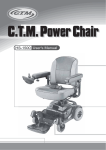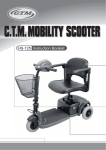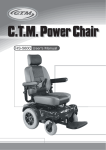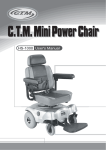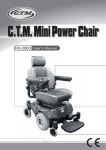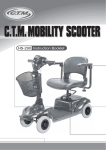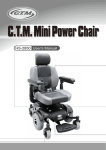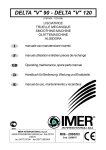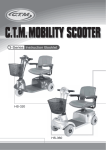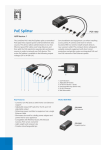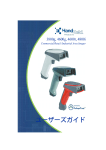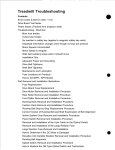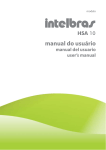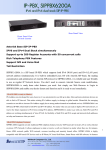Download HS-6200 User`s Manual
Transcript
C.T.M. Folding Power Chair HS-6200 User's Manual HS-6200 User's Manual Table of Contents Introduction.........................................................................1 Electromagnetic Interference and Warnings..........................3 Safety Instructions...............................................................5 Initial Overview....................................................................6 Unpacking and Assembly......................................................8 Special Features................................................................11 Safe Driving Techniques.....................................................14 Batteries and Charging.......................................................16 Tire....................................................................................18 Maintenance,and Cleaning..................................................19 Troubleshooting..................................................................20 Specification......................................................................22 HS-6200 User's Manual INTRODUCTION C.T.M. is a professional and experienced manufacturer, that specializes in production of Mobility Scooters and Power Chairs that are developed by a team of specialists with outstanding design skills and competence. The HS-6200 is an excellent chair that includes ergonomic features. It combines safety and comfort and gives users extraordinary experience and convenience in operation. With its thoughtful and people-friendly controller system, the user can easily achieve 360 degree turns with their finger tips. This product is powered by the sealed, no water added, high performance and, most of all, connectorless lead-acid battery, which ensures environmental safety and brings convenience in disassembly and re-assembly. Preface: This User's Manual contains important information and know-how on operating and maintaining the C.T.M. product. Please read it carefully before practicing with your new chair, so that you comprehend the technical advantages of HS-6200 All assembly and maintenance should be performed after you fully understand the content of this manual to avoid any hazard or damage to the Power Chair or human body. Overhaul and adjustments must be undertaken by skillful maintenance staff following the instructions provided in this booklet. Any improper usage might lead to danger to the user or the chair. C.T.M. is/will not be responsible for any after-effect resulting from failure to comply with this manual. After unpacking, please inspect carefully for any defect or missing part.. Limitation In Transporting And Travelling: 1. When transporting HS-6200, please ensure the product is not scratched or damaged. 2. If a long trip is planned, please fully charge the batteries before use to prevent low voltage during the trip. All the contents in this manual including pictures, photo illustrations and text are all patented and registered. (If any details in the manual are going to be changed or added, C.T.M. will not notify previous owners of the modification.) 1 HS-6200 User's Manual We wish you an enjoyable riding experience. If you have any questions, you can contact: C.T.M.HOMECARE PRODUCT, INC. 6191 Schaefer Ave Suite B Chino CA 91710 Toll Free : 1-866-466-8168 Tel : 909-590-1388 Fax : 909-590-3365 E-Mail : [email protected] http : //www.ctmhomecare.com or your local dealer: 2 HS-6200 User's Manual ELECTROMAGNETIC INTERFERENCE AND WARNINGS CAUTION: It is very important that you read this information regarding the possible effects of Electromagnetic Interference on your power chair. Powered wheelchairs and motorized scooters may be susceptible to electromagnetic interference (EMI), which is interfering electromagnetic energy (EM) emitted from sources such as radio stations, TV stations, amateur radio (HAM) transmitters, two-way radios, and cellular phones. The interference (from radio wave sources) can cause the power chair to release its brakes, move by itself, or move in unintended directions. It can also permanently damage the power chair control system. The intensity of the interfering EM energy can be measured in volts per meter (V/m). Each power chair can resist EMI up to a certain intensity. This is called its "immunity level." The higher the immunity level, the greater the protection will be. At this time, current technology is capable of achieving at least a 20 V/m immunity level, which would provide useful protection from the more common sources of radiated EMI. The immunity level of this product is 20 V/m. There are a number of sources of relatively intense electromagnetic fields in the everyday environment. Some of these sources are obvious and easy to avoid. Others are not apparent and exposure is unavoidable. However, we believe that by following the warnings listed below, your risk to EMI will be minimized. Electromagnetic Interference and Warnings: The sources of radiated EMI can be broadly classified into three types: 1.Hand-held portable transceivers (transmitters-receivers) with the antenna mounted directly on the transmitting unit. Examples include: citizens band (CB) radios, "walkie talkie," security, fire, and police transceivers, cellular telephones, and other personal communication devices. Some cellular telephones and similar devices transmit signals while they are ON, even when not being used. 2.Medium-range mobile transceivers, such as those used in police cars, fire trucks, ambulances, and taxis. These usually have the antenna mounted on the outside of the vehicle. 3 HS-6200 User's Manual 3.Long-range transmitters and transceivers such as commercial broadcast transmitters (radio and TV broadcast antenna towers) and amateur (HAM) radios. Other types of hand-held devices, such as cordless phones, laptop computers, AM/FM radios, TV sets, CD players, and cassette players, and small appliances, such as electric shavers and hair dryers, so far as we know, are not likely to cause EMI problems to your power chair. Power Chair Electromagnetic Interference: Because EM energy rapidly becomes more intense as one moves closer to the transmitting antenna (source), the EM fields from hand-held radio wave sources (transceivers) are of special concern. It is possible to unintentionally bring high levels of EM energy very close to the power chair control system while using these devices. This can affect power chair movement and braking. Therefore, the warnings listed below are recommended to prevent possible interference with the control system of the power chair. Electromagnetic Interference and Warnings: Warnings Electromagnetic interference (EMI) from sources such as radio and TV stations, amateur radio (HAM) transmitters, two-way radios, and cellular phones can affect the power chair. Following the warnings listed below should reduce the chance of unintended brake release or power chair movement, which could result in serious injury. 1.Do not operate hand-held transceivers (transmitters-receivers), such as citizens band (CB) radios, or turn ON personal communication devices, such as cellular phones, while the power chair is turned ON; 2.Be aware of nearby transmitters, such as radio or TV stations, and try to avoid coming close to them; 3.If unintended movement or brake release occurs, turn the power chair OFF as soon as it is safe; 4.Be aware that adding accessories or components, or modifying the power chair, may make it more susceptible to EMI; and 5.Report all incidents of unintended movement or brake release to the distributor listed on the inside front cover of this manual. Note whether there is a source of EMI nearby. Important Information 1.20 volts per meter V/m is a generally achievable and useful immunity level against EMI (as of May 1994). The higher the level, the greater the protection. 2.The immunity level of this product is 20 V/m. 4 HS-6200 User's Manual SAFETY INSTRUCTIONS Safety is the main consideration when practicing with your chair. It is required that you read and comprehend all the operating and safety instructions discussed in this manual. And ensure your chair is correctly fitted and adjusted by your dealer or the prescribing healthcare professional. Make sure to engage the wheel locks before entering or leaving the chair. The wheel locks are designed to prevent movement of the chair. It is preferable to ensure the front castors are in the forward position before transferring in to or out of the chair. With the castors in the forward position the wheel base of the chair is increased and therefore, offers more stability. DO NOT move forward in the seat while leaning forward out of the chair. If an object is to be picked up from the floor, drive past it, then reverse so the front castors are in the forward position. This gives the chair its greatest stability. To maintain lateral stability do not reach further than the length of your arm. DO NOT lean out of the chair as this could cause instability. When transferring, DO NOT stand on the leg rests. Depending on the style of leg rests either swing them away or fold them up before transferring. When approaching a ramp, be sure of your own ability and your limitations in terms of strength and endurance. Before attempting a ramp the following basic safety rules should be considered: 1. 2. 3. 4. Surface of the ramp: Is it too slippery? Degree of incline: Is it too steep to attempt alone? Length of ramp: Is it too long for your endurance? Obstacles: Are there any obstacles on the ramp that would necessitate assistance? Be very careful when going up or down steep inclines If it becomes necessary to stop when going up an incline, special care must be taken to avoid abrupt or sudden forward movement. During continuous forward movements, the chair is capable of falling backwards. Always keep the chair under control when going down a ramp or incline. Speed should be controlled at all times. The user in the power chair and a curb is encountered, caution should be taken to prevent the user being thrown forward: Do not try to climb a curb by driving up it. Have a helper move the chair for you following the instructions below. 1. With both motors disengaged, go down the curb, rear wheels first; making sure that the user is square to the curb so that the rear wheels go down together. 2. To go up a curb forward, verify both front wheels are up together. This must be accomplished with the motors disengaged. Also try to avoid going up multiple steps and using escalators. Use the elevator instead. Please be aware that any adjustments on the power chair may affect the handling and performance. 5 HS-6200 User's Manual INITIAL OVERVIEW Super Responsive Digital Joystick Controller Padded Breathable Ballistic Nylon Back Rest Flip up and Height Adjustable Armrests Connectorless Battery Boxes Fiber Glass Reinforced Nylon Leg Rests 2 High Torque Motors Mated to Precision Sealed for Life Gear reducers Low Profile Cast Aluminum Wheels with Multi-Terrain Tires Figure 1 - HS-6200 Front View 6 HS-6200 User's Manual Handlebar Support Brace Charger Carry-on Bag Height Adjustable Armrests Knob Battery Box Back & Forth Adjstable Armrests Plug Free Wheel Lever Free Wheel Lever Anti-Tip Wheels Figure 2 - HS-6200 Back View Charging Socket Battery Level lndicator speed Indicator Horn On/Off Switch Speed Control Button Figure 3 - Joystick Top View Figure 4 - Joystick Front View 7 HS-6200 User's Manual UNPACKING AND ASSEMBLY Pull two Pull Handles upward from the Holder (A) and (B), then turn outward to take out the battery.(See Fig. 5) Remove the Battery (C) by sliding along the slider.(See Fig. 6) B A C Figure 5 Figure 6 Remove the (D) Leg Band (Accessory).by tear off the Vel-Cro to release the Leg Band (See Fig. 7) Press the Lever (E) on the Footrest Frame downwards, then take out the Footrest Frame by turning it outward.(See Fig. 8) E D Figure 7 Figure 8 Pressing the Delta Tube Pin on the Delta Tube's Delta Tube Lock down to the bottom, then push & pull the Delta Tube to the right side to release the Delta Tube Lock, next step pull Delta Tube downwards to fold up.(See Fig. 9 ) (F) and (F1). Unscrew bolt, (G), release the frame under the seat and fold up.(See Fig. 10) F F1 G Figure 9 Figure 10 8 HS-6200 User's Manual Slowly grasp the centre of the seat upholstery, one hand at the front and the other at the rear, pull the seat upholstery up vertically.(See Fig. 11) Push down the pulled up seat upholstery evenly.(See Fig. 12) Figure 11 Figure 12 Hold the two armrests with your hands, to contract the armrests inwards.(See Fig. 13) Assemble procedure refer to disassemble procedure.(See Fig. 14) Figure 13 Figure 14 9 HS-6200 User's Manual ※When put the battery box (H) back to original position, place the battery box at the slide terminal, (Do not set too far back otherwise the battery box won't be fit into the slide tube accurately.)(See Fig. 15) ※Battery boxes are separate into front and rear sections, please disassemble and assemble accordingly.(See Fig. 16) ※Final step: Using the Pull Handles (I) to secure battery box's position.(See Fig. 17) H I Figure 15 Figure 16 Figure 17 10 HS-6200 User's Manual SPECIAL FEATURES Freewheel levers For your convenience, C.T.M. HS-6200 is equipped with two free wheel levers. These levers allow you to disengage the drive motors and maneuver the chair manually. K J 1.In travelling, set the two metallic levers (J.K) to the Drive position. 2. When the chair stops or malfunctions you can push the levers (J.K) to the Neutral position so the chair is movable by human force. J K Figure 18 Figure 19 DO NOT use your chair while the drive motors are disengaged unless you are in the presence of an attendant! DO NOT disengage the drive motors when your chair is on an incline. The chair could roll down on its own, causing injury! To engage or disengage the free wheel feature: 1. Turn the free wheel levers outward, to engage the drive motors. (See Fig. 18) 2. Turn the free wheel levers inward to disengage the drive motors. (See Fig. 19) It is important to remember that when your HS-6200 is in freewheeling mode, the braking system is disengaged Armrest The height adjustable T-type armrest is provided as standard equipment on the chair. Adjustment for the HS-6200 is facilitated by a thumbscrew fitted from the outside of the armrest support at the lower end. To activate the thumbscrew simply loosen and remove it from the locating hole. (See Fig 20.) The Armrest is liftable by pulling the pin outward. (Figure 21) Figure 20 Figure 21 11 HS-6200 User's Manual 1.The distance of your controller unit can be easily changed for the desired position. To adjust it, loosen L the thumbscrew (L) and slide into or out of the controller bracket.(Figure 22) Figure 22 Seat The C.T.M. chair features seat upholstery that can be tightened. While there should be no adjustment necessary upon delivery of your new chair, over time stretch could occur. Please contact the nearest C.T.M. dealer to have this taken care of if necessary. Below are illustrations of the Seat Options which you can chose to install onto your chair according to your own desires. Figure 23 SPONGE SEAT Figure 24 Figure 25 STANDARD SEAT BREATHABLE CUSHION SEAT & BACKREST Replace worn or torn fabric immediately. Failure to do so may result in a fall and severe injury to you. Seat Belt 1. In driving condition, fasten the seat belt as the picture illustrates. 2. Seat Belt can be unfastened by pressing down the black button (O) (Fig. 26) M N O Figure 26 12 HS-6200 User's Manual Leg Rests The HS-6200 is equipped with a swing-away & detachable leg rests, which are height adjustable. To adjust the height, remove the securing screws and nuts from each side and slide the extension tube and leg rests up or down to the desired height. Retighten the securing hardware as Fig. 27 shows Figure 27 Options : There are elevating leg rests as an option. Never lift the wheelchair by the leg rests. These parts are detachable and will not bear the weight of this chair. Lift this chair ONLY by nondetachable parts of the main frame. Controller 1.Directional movement is attained by controlling the P joystick (P) ; move the joystick toward the direction intended. HS-6200 is without turning limitation, it can circle 360 degrees without problem. Figure 28 Circuit Braker 1.When the electric circuit is overloading or malfunctioning Q the Circuit Braker will automatically shut off the main power of the chair to ensure safety in performance. Pressing down the button (Q) should restore mobility. Figure 29 13 HS-6200 User's Manual SAFE DRIVING TECHNIQUES Driving your Chair Before sitting on your chair, verify: 1. The chair is switched off. 2. Swing away the armrests and leg rests if appropriate. 3. The battery charger is disconnected from both the chair and the wall outlet. Once on your chair, make sure that you are comfortably positioned and that the leg rests and armrests have been adjusted to suit your needs. The position of the joystick should be within reach to eliminate hand and arm exhaustion when driving. To Begin : 1. Set the speed control of the chair to SLOW. 2. Press the "on / off" switch. 3. Allow two seconds to elapse before engaging the joystick. This is a safety feature to prevent sudden starts. 4. Push the joystick gently forward applying a steady even pressure. The further you push the joystick, the faster the chair will go. The chair will stop when you return the joystick to the neutral or vertical position. 5. Directional control is achieved by gently swivelling the joystick in the direction you wish to go. Pull back to reverse. 6. The controller can be programmed to give you the best feel for all driving situations and only needs a light touch to respond. In the case of an emergency, let the joystick go and the chair will come to a stop. Safe Driving 1. Never drive at a speed greater than your ability to safely control your chair. Remember that wet or loose surfaces need greater care and control. 2. Always turn the chair OFF when transferring on or off or while the chair is stationary for long periods. 3. Avoid jerky stop / start motions as this will result in excessive current draw from the batteries, increased tire wear and the rapid wearing of the gearbox and motors. 4. Keep your chair clean from sand and salt water. Indoor / Outdoor Driving When driving indoors keep the speed to a minimum to avoid the risk of collision. For outdoor driving be cautious of wet surfaces, loose sand, large curbs and potholes. A little practice will ensure you understand the capabilities of your chair and enable you to overcome the most common obstacles encountered when driving. 14 HS-6200 User's Manual Chair Operation on surfaces that require Special Care When driving up or down ramps it is recommended that the user: 1. Visually checks to see if the angle of the slope is less than 10 degrees. 2. Checks to see that the ramp surface is roughened to prevent slippage. 3. Ensures that the ramp surface is correctly in line with the tires and is wide enough to allow the tires to pass freely along the ramp. If the ramp meets these conditions, it is recommended that the user drives the wheelchair slowly up or down the ramp, ensuring that the chair is driven in the centre of the ramp tracks. If possible, have an assistant monitor the chairs' progress, and prevent tipping of the chair by holding the push handles at the back of the seat. If the ramp does not meet these conditions, it is recommended that alternative methods for climbing and descending be found. Chair Response Should the chairs' response not be to your satisfaction, ask your dealer to adjust the program to a level at which you are comfortable. This program can be altered at anytime to either increase the response rates in line with your improved motor skills or to lower the rates to a level at which you feel comfortable and in control. Curbs It is recommended that before the user attempts to climb or descend a curb that the user visually checks the height of the curb to ensure that it does not exceed 1.1" in height. If the curb height is less than 1.1", the user should approach the curb at right angles to the curb line at a slow speed, climb or descend the curb slowly so as to keep the chair under control. When climbing the curb, the user may find it easier to reverse the chair up the curb. If the curb height is greater than 1.1", it is not recommended that the user climb or descend the curb. Steep Slopes When the power wheelchair is to be operated up and down steep slopes, it is recommended that the user: 1. Visually checks to see if the angle of the slope is less than 10 degrees. 2. Checks that the slope surface is roughened to prevent slippage. If the slope meets these conditions, it is recommended that the user approach the slope at a slow speed, keeping the chair under control at all times. It may be preferable to track across the slope so as to decrease the steepness of the descent providing that the surface of the slope is wide enough and suitable to prevent slippage. 15 HS-6200 User's Manual If the slope does not meet these conditions, it Is recommended that the user does not climb or descend the slope. BATTERIES AND CHARGING When your batteries are fully charged you should have sufficient power to give you all the mobility required in a day. It is important that you understand how your batteries and charger work. Batteries must be charged before using the power chair for the first time and are recommended to be charged up to 10 - 14 hours after each day's use. Charging the Batteries 1. 2. 3. 4. 5. Batteries should be charged every night in a well ventilated room. DO NOT place the power wheelchair near radiators or open fireplaces while charging. DO NOT smoke or permit open flames in the immediate vicinity. Turn the chair controller power off before charging. It is advisable that the batteries be charged for a minimum of 10 hours per night to ensure full battery storage capacity. The battery charger is an automatic current limiting device and will shut off when the batteries are fully charged. Charging the batteries : 1. Position HS-6200 power chair next to a standard wall outlet. 2. Connect the battery charger to the wheelchair input battery charging socket, which is located on the front of the controller. 3. Connect the battery charger to a standard wall power outlet. 4. Switch the power on. During the recharge : 1. While the batteries are being recharged, a red light will appear on the battery charger, indicating that the power is connected and charging is in progress. At the end of the recharge cycle: 1. A green light will appear on the charger. This indicates that the batteries are fully charged and ready for use. 2. If fitted, the battery charge level indicator on the controller should also show a full charge when switched on. When do the batteries need recharging? When the batteries fall below 20% of the maximum charge level, the serles of lights on the controller will flash. 1. Do not use batteries other than the recommended type for your chair and never use a charger other than the one supplied for that purpose. 2. If the chair is not used for a long period of time arrange to have the batteries charged for at least one day (10 hours) every month, minimum. 3. Periodically, check that the battery terminals are clean and the connections are tight. Smear a thin film of petroleum jelly on the terminals to guard against corrosion. Always wash your hands after handling batteries. 16 HS-6200 User's Manual Replacing the batteries CAUTION ! - If you have doubts about your ability to lift any components, it is recommended that you seek qualified dealer so as to avoid injury. 1. Turn the power off. 2. Disconnect the battery connection plug at the front of the battery tray. 3. Release the securing belt holding the battery box. 4. Disconnect the battery connection cables located in the battery box. 5. Lift the rear battery out of the battery box by using the lifting strap. 6. Slide the front battery to the rear of the battery box and remove the battery as in step 5. 7. Undo the terminal lugs, noting the polarity of the lugs. Remove the wiring loom. 8. Repeat step 7 for the other battery. 9. Inspect the terminals on the wiring loom and the lugs on the replacement batteries to make sure they are clean. If they are not, clean with a warm solution of bicarbonate of soda and water. It is important that you wash your hands afterwards. 10. Connect the terminal lugs on the wiring loom to the new batteries, observing the polarity of the lugs as noted before. 11. Place the new batteries back into the battery box and rejoin the connectors. 12. Replace the battery box lid and secure the retaining belt. 13. Reconnect the power cable. For maximum performance it is recommended that you replace both batteries at the same time 17 HS-6200 User's Manual TIRE You should inspect the tires frequently for damage, the presence of foreign bodies, unusual wear and sufficient tread depth. Tread depth should if possible not be allowed to drop below 1/16". If replacement tires are needed, please contact the nearest C.T.M. dealer. Front wheels : 8" solid tires. Rear wheels : 13" solid tires. Follow these easy steps to replace the tire: 1. Use an ratchet and socket to remove the drive wheel screw from the centre hub of the wheel. See Fig 30. 2. Pull the wheel off of the axle. 3. Separate the tire from the rim. 4. Remove the old tire and replace it with a new tire. 5. Slide the wheel back onto the shaft. 6. Install the drive wheel nut into the centre hub and verify the key is lined up with axle and wheel. Then tighten to secure it in place. Figure 30 18 HS-6200 User's Manual MAINTENANCE, AND CLEANING An electric wheelchair needs some basic attention to ensure it provides reliable service. We recommend that the user ensures that the power wheelchair is checked regularly for maintenance requirements and receives a thorough, annual maintenance check up. Annual Maintenance We recommend that the chair has at least one full service per year from an authorized dealer. This will ensure that your power chair is functioning properly and also helps prevent future complications. This should include: 1. 2. 3. 4. 5. Checking Checking Checking Checking Checking the the the the the tires. batteries and terminals. controller program for the user's needs. frame. upholstery condition. Regular Maintenance and Cleaning 1. Avoid knocking or bumping the controller, especially the joystick. 2. Avoid prolonged exposure of your power chair to extreme conditions, such as heat, cold, or moisture. 3. Keep the controller clean. 4. Check that all controller connectors are tight and secured properly. 5. Never hose off your power chair or place it in direct contact with water. 6. Keep the upholstery and frame clean by wiping with a soft cloth, particularly after driving through wet, sandy or muddy conditions. Do not use harsh abrasive materials when cleaning. Do not apply liquid cleaners or solvents directly to the control box, battery charger or any electrical connections. 7. Keep wheels free from lint, hair, sand and carpet fibres. 8. Lightly oil axle pin, wheel axles and bearings once every three months, if necessary. 9. Inspect the tires. Tread depth should not be allowed to drop below 1/16". 10. Use only recommended batteries and have batteries changed by Qualified Dealer if you have doubts about your ability to lift the components. 11. Charge batteries regularly. Make sure the charger lead plugs are engaged properly in the sockets. Do not disconnect by pulling the cord. 12. With the controller turned off, check the joystick. Make sure it is not bent or damaged and that it returns to the center when you release it. Check the rubber boot around the base of the joystick for damage. Visually inspect the boot. Do not handle or try to repair it. See your authorized dealer for any questions. 13. Visually inspect the controller harnesses. Make sure that they are not frayed, cut or have any wires exposed. See your authorized dealer if there is a problem with any of these harnesses. 14. Ensure that all parts of the controller system are securely fastened to your HS-6200. Do not over tighten any screws. 19 HS-6200 User's Manual TROUBLESHOOTING Here are some suggestions about solving problems you may have with your power chair. There are 10 LED Self-Diagnostic Warning Lights on the Control Panel. To check the Self-Diagnostic Warning Lights, turn the power chair on and count the number of flashes. Number of Flashes Solution 1 bars The battery needs charging or there is a bad connection to the battery. Check the connections to the battery. If the connections are good, try charging the battery. 2 bars The left hand motor* has a bad connection. Check the connections to the left hand motor. 3 bars The left hand motor* has a short circuit to a battery connection. Contact your service agent. 4 bars The right hand motor* has a bad connection. Check the connections to the right hand motor. 5 bars The right hand motor* has a short circuit to a battery connection. Contact your service agent. 6 bars The wheelchair is being prevented from driving by an external signal. The exact cause will depend on the type of wheelchair you have, one possibility is the battery charger is connected. 7 bars A joystick fault is indicated. Make sure that the joystick is in the center position before switching on the control system. 8 bars A control system fault is indicated. Make sure that all connections are secure. 9 bars The parking brakes have a bad connection. Check the parking brake and motor connections. Make sure the control system connections are secure. 10 bars An excessive voltage has been applied to the control system. this is usually caused by a poor battery connection. Check the battery connections. If the programmable parameter, Motor Swap, has been changed then left and right hand references in this table will need transposing. 20 HS-6200 User's Manual Other Problems: •Power chair will not move when the power is turned on: 1.Check the Battery Level Indicator on the joystick. All the LED lights should be on. 2.Check the Self-Diagnostic Warning Light. It should be steady. If it is flashing, see the chart on page 20 for the problem identification. 3.Check all electrical connections to be sure they are tight. 4.Verify the batteries are connected correctly. Refer to "Installation of Batteries" on page 10. 5.If none of these suggestions correct the problem, contact your authorized dealer. •If charging your power chair over 14 hours and the light on the charger does not change to green, then contact your authorized dealer. Please note that your power chair is equipped with a controller that constantly checks the drive system for a safe and enjoyable ride. If an error occurs, the Battery Level Indicator will provide you an indication of the problem by way of flashing lights. We thank you again for choosing C.T.M. for your power chair. C.T.M. offers exceptional, uncompromised quality, for better mobility. "When you compare, the decision will be obvious: C.T.M." 21 HS-6200 User's Manual SPECIFICATION SPECIFICATIONS HS-6200 HS-6200N Overall Length 42.3" 41.1" Overall Width 24" 23.2" Overall Height 35.4" 35.4" Wheels: Front 8" 8" Wheels: Middle N/A N/A Wheels: Rear 13" 13" 156.3 lbs 154.8 lbs Max. Speed 5 mph 5 mph Weight Capacity 280 lbs 280 lbs 1.8" 1.8" 10 degree 10 degree Curb Climbing 1.1" 1.1" Turning Radius 38.6" 36.2" Electro-Mechanical Electro-Mechanical 18" 16" Weight w/ Batteries Ground Clearance Grade Climbable Brake Seat Width Drive Train 2-Motor Rear-Wheel Drive 59.5 lbs 59.5 lbs 420W 4600r.p.m 420W 4600r.p.m Travel Range 11.9 mile 11.9 mile Battery 36 Ah x 2 36 Ah x 2 Charger 5A 5A Electronics PG-VSI PG-VSI Seat Type Padded, Breathable Ballistic Nylon Back Rest Battery Pack Weight Motor Size *Subject to change without notice. 22
























